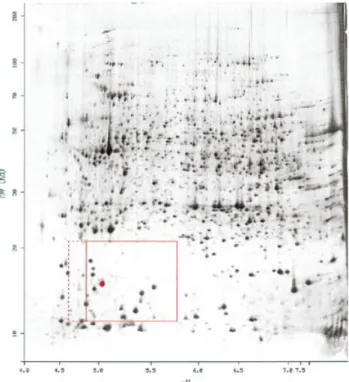1998 Oxford University Press
332–333 Nucleic Acids Research, 1998, Vol. 26, No. 1
Current status of the SWISS-2DPAGE database
Christine Hoogland*
,
Jean-Charles Sanchez
1,
Luisa Tonella
1,
Amos Bairoch
2,
Denis F. Hochstrasser
1and Ron D. Appel
Laboratoire d’Imagerie Moléculaire et Bioinformatique, Division d’Informatique Médicale, Hôpital Cantonal
Universitaire, 24, rue Micheli-du-Crest, CH-1211 Genève 14, Switzerland, 1Central Clinical Chemistry Laboratory,
Geneva University Hospital, Geneva, Switzerland and 2Department of Medical Biochemistry, University of Geneva, Geneva, Switzerland
Received September 26, 1997; Accepted October 3, 1997
ABSTRACT
The SWISS-2DPAGE database (http://www.expasy.ch/ ch2d/ch2d-top.html ) consists of two-dimensional polyacrylamide gel electrophoresis images, as well as textual descriptions of the proteins that have been identified on them. The current release contains 15 reference maps from human biological samples, as well as from Saccharomyces cerevisiae, Escherichia coli and Dictyostelium discoideum origin. These refer-ence maps have 2088 identified spots, corresponding to 410 separate protein entries in the database, in addition to virtual entries for each SWISS-PROT sequence.
INTRODUCTION
SWISS-2DPAGE is a database containing experimental data available from two-dimensional polyacrylamide gel electro-phoresis (2-D PAGE) (1). Identification of proteins on 2-D PAGE maps is actually obtained by microsequencing, immunoblotting, amino acid composition analysis, gel comparison, and peptide mass fingerprinting using mass spectrometry or by combination of these technics (2). The SWISS-2DPAGE database thus assembles textual description for the proteins identified, includ-ing mappinclud-ing procedures, physiological and pathological informa-tions, experimental data (isoelectric point, molecular weight, amino acid composition) and bibliographical references, in addition to the various 2-D PAGE images showing the protein locations. Cross-references are provided to Medline, to other 2-D PAGE databases (ECO2DBASE, HSC-2DPAGE, YEPD) and to SWISS-PROT, which provides many links to other molecular databases (EMBL, GenBank, PROSITE, OMIM, etc.).
FORMAT
The protein entries in SWISS-2DPAGE are text files structured to be readable by human as well as by computer programs. Each entry is composed of defined lines, used to record various kinds of data (Fig. 1). For standardization purposes, the format of SWISS-2DPAGE entries is similar to the SWISS-PROT database (3), in addition to specific lines dedicated to the 2-D PAGE data:
Figure 1. Example of a protein entry from SWISS-2DPAGE.
(i) the master line (MT) lists the reference maps where the entry has been identified; (ii) the images line (IM) lists the 2-D PAGE images available for the entry; (iii) the 2D lines group different topics including the mapping procedure, spot co-ordinates, protein amino acid composition, protein expression levels and modifications. On the ExPASy Web server (see availability section) the data image associated with a protein entry displays the experimental location of the protein on the chosen map, in addition to a theoretical region computed from the protein sequence (Fig. 2).
CURRENT CONTENT
Release 6 of SWISS-2DPAGE (September 1997) contains 15 reference maps from human: cells or tissues (kidney, liver, lymphoma, platelet cells, red blood cells), body fluids (cere-brospinal fluid, plasma), culture cells (erythroleukemia cell line, hepatoblastoma carcinoma derived cells, hepatoblastoma carci-noma derived cell line secreted proteins, macrophage like cell
333
Nucleic Acids Research, 1994, Vol. 22, No. 1Nucleic Acids Research, 1998, Vol. 26, No. 1 333
Figure 2. The protein from Figure 1 shown on the DICTYSLUG reference map.
line, promyelocytic leukemia derived cells), and from
Saccharo-myces cerevisiae, Escherichia coli and Dictyostelium discoideum
origin. Table 1 gives detailed description for each of these maps, including creation and release dates, number of detected spots, number of identified spots and number of distinct protein entries. There is a total of 410 protein entries. In addition, there are as many virtual entries as protein sequences in the SWISS-PROT database.
User manual and release notes are also included in this release, as well as experimental protocols for 2-D PAGE and post-separ-ation analysis (including photographs of each procedure).
AVAILABILITY
The most efficient and user-friendly way to interactively browse in SWISS-2DPAGE is through the ExPASy World Wide Web molecular biology server (URL is http://www.expasy.ch/ ). The SWISS-2DPAGE top page (URL: http://www.expasy.ch/ch2d/ ch2d-top.html ) provides several text searches, and displays results with active links to other databases. It is also possible to get a local copy of SWISS-2DPAGE using anonymous ftp (File Transfer Protocol) from the ExPASy FTP server (ftp://ftp.expasy. ch/databases/swiss-2dpage/ ).
Table 1. Content of SWISS-2DPAGE
Map Creation Last modification Detected spots Identified spots No. of entries CSF AUG-93 JUN-97 1664 309 30
DICTYSLUG SEP-97 SEP-97 3164 25 16
ELC AUG-93 JUN-97 2144 35 19
ECOLI AUG-95 SEP-97 2364 200 178
HEPG2 AUG-93 SEP-97 2862 98 45
HEPG2SP AUG-93 JAN-96 1734 155 25
HL60 SEP-97 SEP-97 3164 26 17
KIDNEY SEP-97 SEP-97 2896 42 27
LIVER AUG-93 SEP-97 2413 138 68
LYMPHOMA AUG-93 JUN-97 1890 60 33
PLASMA AUG-93 SEP-97 1966 626 70
PLATELET AUG-93 JUN-97 2193 41 18
RBC AUG-93 SEP-97 1800 190 33
U937 AUG-93 JUN-97 895 42 32
YEAST FEB-95 JUN-97 1940 101 62
Abbreviations as follows: CSF, cerebrospinal fluid; DICTYSLUG, Dictyo-stelium discoideum; ELC, erythroleukemia cell line; ECOLI, Escherichia coli; HEPG2, hepatoblastoma carcinoma derived cells; HEPG2SP, hepatoblastoma carcinoma derived cell line secreted proteins; HL60, promyelocytic leukemia derived cells; RBC, red blood cells; U937, macrophage like cell line; YEAST, Saccharomyces cerevisiae.
ACKNOWLEDGEMENTS
The authors thank S. Frutiger, G. Hughes, M. Wilkins, N. Packer, A. Gooley, K. Williams, B. Walsh, M. Molloy, K. Ou and B. Herbert for their assistance in protein identification, J. Yan for providing Dicty data, C. Sarto for Kidney data, J. Carron for HL60 data, C. Pasquali for E.coli data and F. Ravier, S. Jaccoud, I. Demalte and V. Rouge for their technical assistance.
REFERENCES
1 Herbert,B.R., Sanchez,J.-C. and Bini,L. (1997) In Wilkins,M.R., Williams,K.L., Appel,R.D. and Hochstrasser,D.F. (eds), Proteome Research: New Frontiers in Functional Genomics. Springer Verlag, Berlin, Heidelberg, New York, pp. 13–33.
2 Wilkins,M.R. and Gooley,A.A. (1997) In Wilkins,M.R., Williams,K.L., Appel,R.D. and Hochstrasser,D.F. (eds), Proteome Research: New Frontiers in Functional Genomics. Springer Verlag, Berlin, Heidelberg, New York, pp. 35–64.
